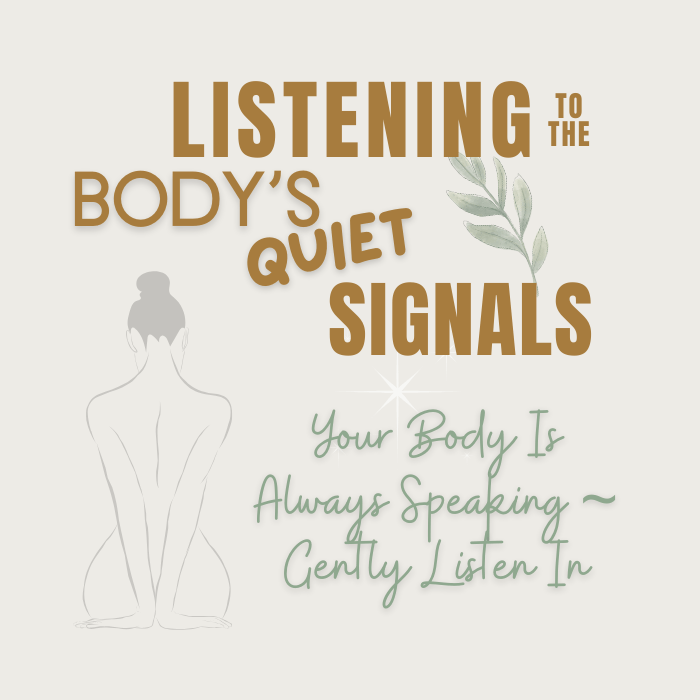Your body is speaking to you all the time
In a world that often encourages pushing, rushing, and overriding inner cues, it’s easy to miss the quiet ways the body communicates. Listening to the body’s signals is a gentle, powerful act of healing — one that reconnects you with safety, truth, and your own inner wisdom.
Learning to listen — truly listen — to your body’s quiet signals is one of the most profound acts of healing you can offer yourself.
It’s about rebuilding a relationship with your body that was never truly lost.
Some links on this page are affiliate links. If you choose to purchase through them, it supports this site at no extra cost to you. Thank you for your support. 🤍
Why Listening Matters
The body remembers what the mind forgets.
- It remembers the moments when love felt unsafe.
- It remembers the times when boundaries were crossed.
- It remembers joy, grief, fear, and belonging — even when our conscious minds move on or block it out.
When we ignore the body’s signals — tightening in the chest, shallow breath, a sudden heaviness or restlessness — we risk staying trapped in old survival patterns without even realizing it.
But when we listen gently, without rushing to fix or explain, the body feels seen.
It softens. It begins to trust again.
Healing unfolds through relationship, gently, not through force.
✨ If you’d like to explore how survival patterns live in the body and how to gently soften them, you might enjoy:
Where Fear Hides in the Body
If you’d like a simple, compassionate framework for understanding your internal experience, The Change Triangle by Hilary Jacobs Hendel offers a beautiful starting point. It helps map the journey from survival responses to core truths — with kindness and clarity.
What Do “Body Signals” Look Like?
Body signals are often subtle. They may show up as:
- A fluttering in the stomach
- A tightening in the throat
- A sudden urge to move away from a situation
- Goosebumps, yawning, or chills
- A wave of exhaustion that seems to come from nowhere
- A pulling sensation toward or away from a decision
- A deep, quiet knowing that has no words
They are the language of your nervous system, trying to keep you safe, connected, and aligned.
How to Begin Listening Gently
🌿 Slow down.
Most body signals are missed because we are moving too fast to notice them.
Even a few slow breaths can open a doorway to sensing more deeply.
🌿 Name sensations without judgment.
Instead of labeling a sensation as “bad” or “stupid”, try simply describing it: “Tightness in chest,” “Warmth in belly,” “Buzzing in hands.” Removing judgement opens you up to receiving more clarity and truth.
🌿 Create small listening rituals.
- One minute of body scanning before sleep
- Pausing after conversations to notice any residual feelings
- Sitting with a hand over the heart for a few breaths each morning
🌿 Offer gratitude.
Even if a sensation feels uncomfortable, thank your body for communicating.
“Thank you for showing me.”
🌿 Trust the quiet.
Some days, you may not feel much. That’s okay. Trust that the connection is building — even when it’s subtle.
Grounding the body often makes it easier to hear these quiet signals. If you’d like gentle tools for grounding, you might find this helpful:
Grounding Practices to Calm the Nervous System →
Common Challenges When Listening to the Body
Discomfort
Sometimes the first thing we notice is pain, tension, or sadness.
It’s tempting to run away — but staying gently present can allow these feelings to move and soften.
Doubt
You might wonder, “Am I making this up?”
Trust that sensing your own inner landscape is a real skill — one you are allowed to relearn at your own pace.
Overwhelm
If listening feels too intense, it’s okay to pause.
Ground yourself first (feet on the floor, hand on heart) before returning to sensing.
A Gentle Closing Reflection
Your body is not against you.
~It is wise.
It is speaking in the only language it knows: sensation, breath, feeling, intuition.
When you slow down and listen — truly listen —
you begin to move through life in softer alignment with yourself.
You are not here to override your body.
You are here to reunite with it.
🌿 FAQ
How can I tell the difference between fear and intuition?
Fear often feels urgent, frantic, tight, or demanding.
Intuition tends to feel quieter, steadier, and more neutral — even if it invites uncomfortable change.
Both deserve to be listened to — but intuition rarely rushes.
What if I don’t feel anything when I try to listen?
Numbness or disconnection is a signal too.
It often means your system needed to disconnect for protection — and is slowly relearning how to feel safely again.
Start small. Trust that sensing will return gently over time.
As you reconnect with your body’s signals, you may naturally begin healing deeper emotional patterns too. If it speaks to you, you’re welcome to continue here:
Healing Emotional Patterns
Deepening Resources
The Mindful Self-Compassion Workbook
A gentle companion for reconnecting with your inner experience.
Use this when emotional signals arise but feel confusing, intense, or hard to welcome. Includes written and audio practices grounded in self-kindness.
The Vagus Nerve Deck: 75 Exercises to Reset Your Nervous System
Trauma-informed, polyvagal-based exercises to help your body feel safe enough to listen inward.
These gentle practices support your ability to notice body signals, especially when anxiety, numbness, or shutdown make it hard to feel what’s true.
Your unfolding is already underway — and it’s beautiful.

